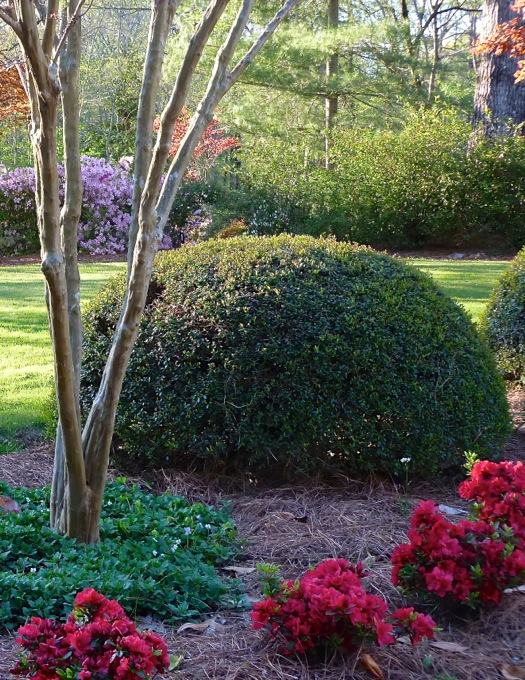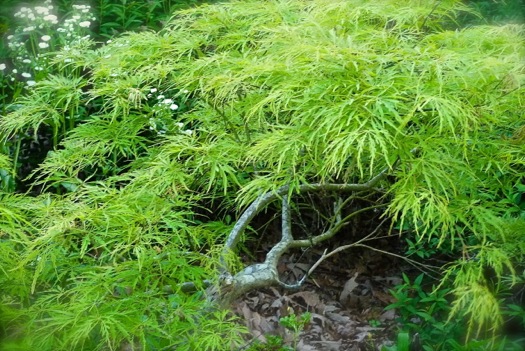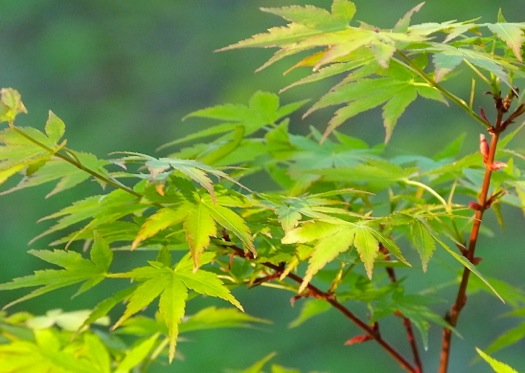Great Shrubs For Spring Color
 Monday, April 11, 2016 at 9:50PM
Monday, April 11, 2016 at 9:50PM My garden relies heavily on shrubs and small trees for spring color; nothing in the landscape is easier or more reliable to produce swathes of fresh, bright foliage and lovely flowers. Shrub border by the patio, April 2016
Shrub border by the patio, April 2016
The azaleas have been gorgeous, though most of their blooms are past their prime now. The bright red-orange azalea in the following photo is the evergreen Karume azalea 'Hershey Orange.'
'Autumn Fire' is a new Encore azalea recently planted by the parking area in front of the house. Although it is fabulous in the fall, it is just as spectacular in spring: Encore 'Autumn Fire' azaleas bloom in front of dwarf Yaupon Holly.
Encore 'Autumn Fire' azaleas bloom in front of dwarf Yaupon Holly.
Viburnum macrocephalum, commonly called Chinese Snowball Viburnum, is another shrub blooming prolifically at present:
Behind and to the right of the Snowball viburnum in the image above is Philadelphus, commonly called Mock Orange or English Dogwood, just beginning to bloom:
Next to the patio is this lovely weeping lace leaf Japanese maple:
Most of my roses are low-maintenance, work horse type roses, but I think they are all beautiful. They are just beginning to bloom in the front garden. Here are a couple: Rosa 'Mutabilis', also called butterfly rose
Rosa 'Mutabilis', also called butterfly rose
 Rosa Rugosa 'Alba'
Rosa Rugosa 'Alba'
Caryopteris incana 'Jason' glows near the patio. Later this summer it will have blue flowers that attract butterflies:
Acer palmatum 'Sango-kaku', also called Coral Bark Maple, grows in the arbor garden:
Spreading Yew is another favorite in the woodland garden. I love how its lime green new growth contrasts with its darker bluish-green needles:
Cryptomeria japonica 'Tansu' is a dwarf Japanese cedar in the woodland garden. It has stiff, somewhat prickly evergreen foliage:
Here are more of my favorite shrubs for foliage: Clockwise from top left: Variegated osmanthus; Pieris japonica; Juniper 'Saybrook Gold'; Variegated Japanese pittosporum; Sambucus 'Lemony Lace'; Spirea 'Goldflame'; Variegated hydrangea; Deodar cedar 'Feelin' Blue.'
Clockwise from top left: Variegated osmanthus; Pieris japonica; Juniper 'Saybrook Gold'; Variegated Japanese pittosporum; Sambucus 'Lemony Lace'; Spirea 'Goldflame'; Variegated hydrangea; Deodar cedar 'Feelin' Blue.'
Finally, I am enjoying the sweet honeysuckle fragrance and pretty blooms of deciduous azaleas in the woodland garden. I have planted several varieties so that they will be blooming at different times from now into summer: